
--- Fivefold forms of Brahman in Rg Veda ---
“janma karma ca me divyam” - One must know inner meanings of his acts & forms he assumes during avatārās. This is called “avatāra rahasyam” by ācāryās & is fhe intent of this sūkta: sacred-texts.com/hin/rigveda/rv…
“janma karma ca me divyam” - One must know inner meanings of his acts & forms he assumes during avatārās. This is called “avatāra rahasyam” by ācāryās & is fhe intent of this sūkta: sacred-texts.com/hin/rigveda/rv…
https://twitter.com/DefiledGod/status/1309048817975787522?s=19
Who are these gods in these mantras? Well, these rks are not describing various gods, but various forms of the same god.+
#Hinduism #Vedas #SanatanaDharma #RigVeda #Sanatani #SanatanDharm #Hindus #Vedanta
#Hinduism #Vedas #SanatanaDharma #RigVeda #Sanatani #SanatanDharm #Hindus #Vedanta
This god takes a fivefold form – para (supreme abode), vyūha (among the devas), vibhava (among us), antaryāmin (in all beings) and arca (visible to all in temples). Of these, vibhava is further divided 3-fold and antaryāmin as 2-fold, which we will see+
#Hinduism #Vedas
#Hinduism #Vedas
As the Puruṣa Sūkta says, “ajāyamāno bahudhā vijāyate” – Unborn, he is born in many ways. Exactly what “bahudhā” is, is explained here in these rks+
#Hinduism #Vedas #SanatanaDharma #Vedic #RigVeda #RigVed
#Hinduism #Vedas #SanatanaDharma #Vedic #RigVeda #RigVed
A small note: The translation of the rk is provided in the tweets. For explanation of how the translation is derived, refer the short notes in the attached screenshots for each tweet.
We start now with 1st of 5 forms, viz., paravāsudeva in the Supreme Abode, as below+
#Vedas
We start now with 1st of 5 forms, viz., paravāsudeva in the Supreme Abode, as below+
#Vedas
babhrureko viṣuṇaḥ sūnaro yuvāñjyaṅkte hiraṇyayam
[One (Paravāsudeva) is supporter (of muktas), of nature distinct from & higher to all, with imperishable agreeable kalyaṇa guṇās, ever young, applies ointment (knowledge or literal) to mukta desirous to him like gold]+
[One (Paravāsudeva) is supporter (of muktas), of nature distinct from & higher to all, with imperishable agreeable kalyaṇa guṇās, ever young, applies ointment (knowledge or literal) to mukta desirous to him like gold]+
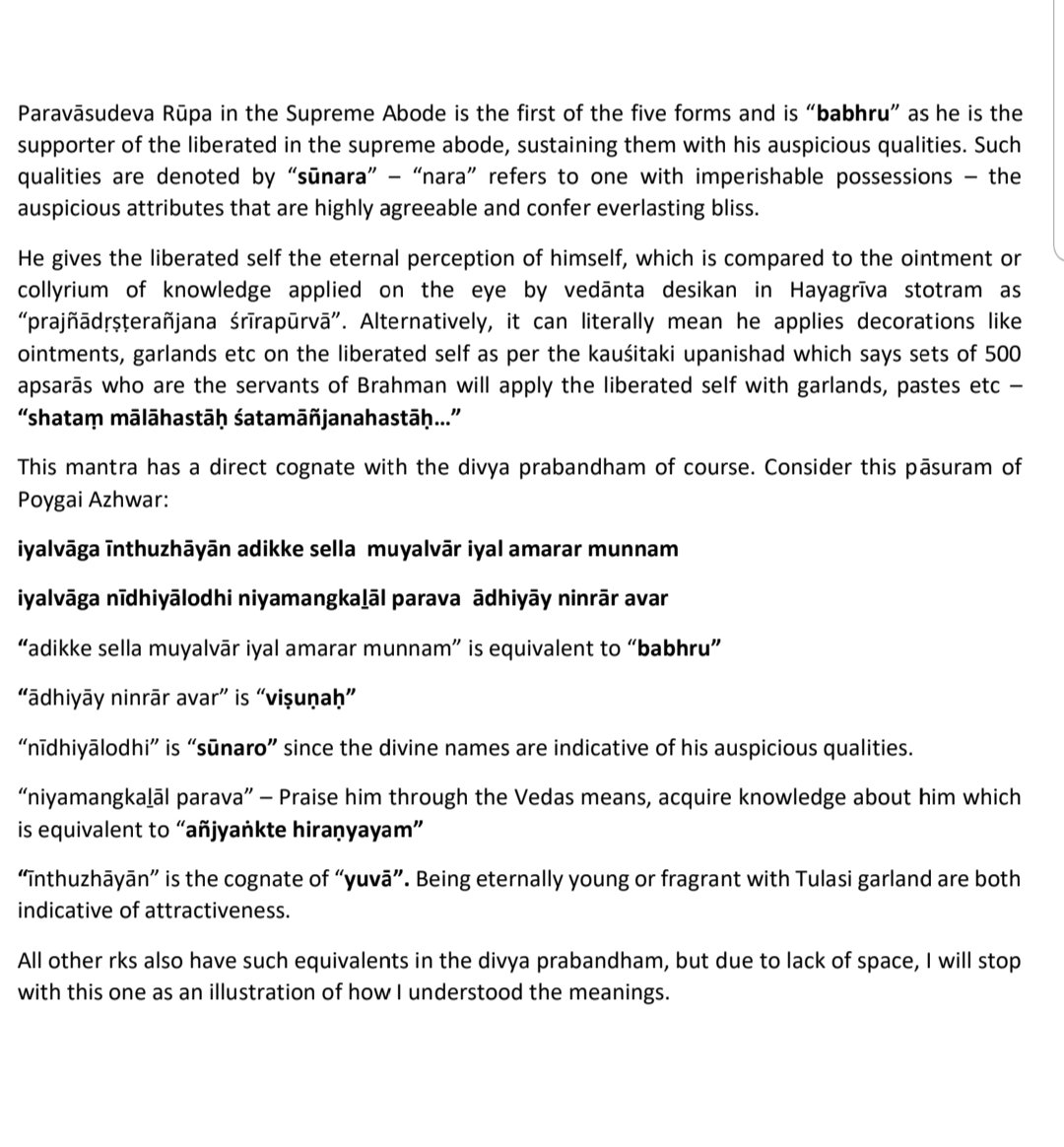
From paravāsudeva, come the vyūhās, each with 2 of the 6 major attributes. Next 3 rks describe the 3 vyūha forms – Pradyumna (Aiśvarya & Vīrya), Aniruddha (Sakti and Tejas) and Sankarśana (Jñāṇa & Bala) as below. Refer screenshots for description in each tweet:+
#Hinduism
#Hinduism
yonimeka ā sasāda dyotano.antardeveṣu medhiraḥ
[One (Pradyumna) is seated in Brahmā who is cause/abode of the Jagat, shines unchanged despite act of creation, abiding as innerself of propagators of Sāstra (Manu, Vyāsa etc), possessing knowledge as he instructs the Veda]+
[One (Pradyumna) is seated in Brahmā who is cause/abode of the Jagat, shines unchanged despite act of creation, abiding as innerself of propagators of Sāstra (Manu, Vyāsa etc), possessing knowledge as he instructs the Veda]+

vāśīmeko bibharti hasta āyasīmantardeveṣu nidhruviḥ
[One (Aniruddha) bears a weapon of iron (signifying strength/sturdiness) in his hand for protection of the gods, residing among the gods in the milky ocean, firm as the basis or support for maintenance of the Universe]+
[One (Aniruddha) bears a weapon of iron (signifying strength/sturdiness) in his hand for protection of the gods, residing among the gods in the milky ocean, firm as the basis or support for maintenance of the Universe]+
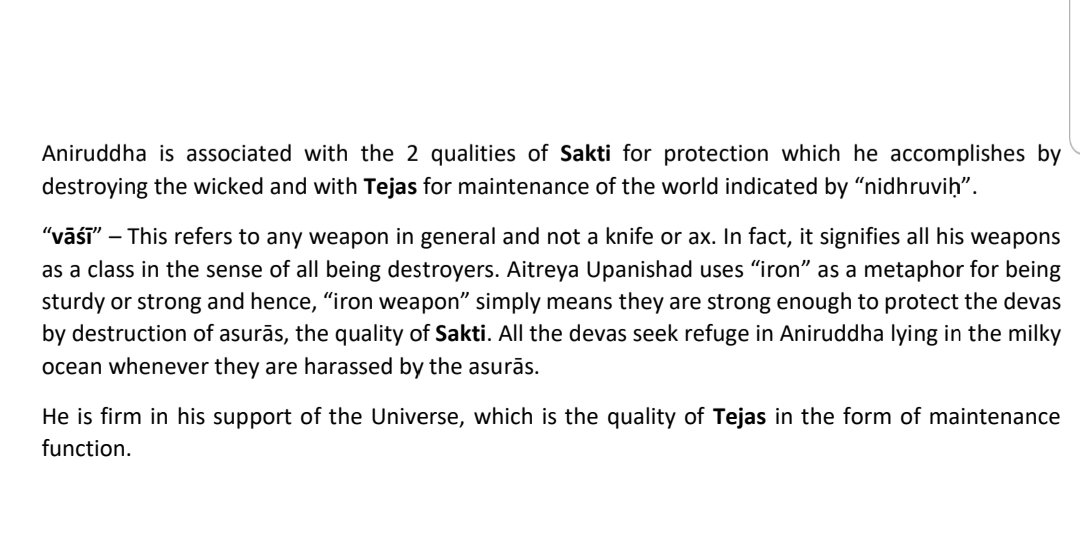
vajrameko bibharti hasta āhitaṃ tena vṛtrāṇi jighnate
[One (Sankarshana) holds the Chakra which is the “vajra” in his hand, by which the karmas that cover knowledge (vṛtrāṇi) are destroyed, having deposited the selves in himself during pralaya (āhitaṃ).]+
#Hinduism
[One (Sankarshana) holds the Chakra which is the “vajra” in his hand, by which the karmas that cover knowledge (vṛtrāṇi) are destroyed, having deposited the selves in himself during pralaya (āhitaṃ).]+
#Hinduism
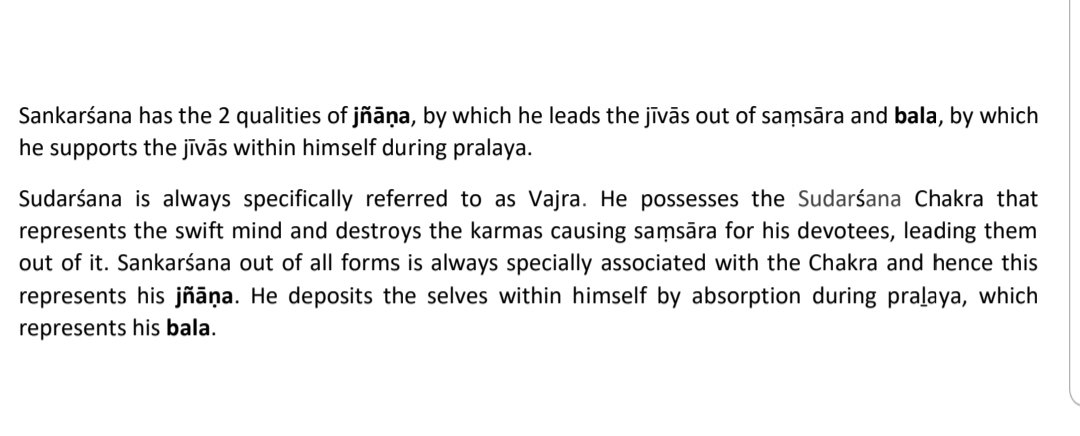
From Aniruddha, arise the antaryāmin, vibhava and arca. First, the antaryāmin – this is two-fold. The first is the form of the Lord in the lotus of the heart, as meditated by the Yogins. As below+
#Hinduism #Vedas #SanatanaDharma #Vedic #Sanatani #RigVeda
#Hinduism #Vedas #SanatanaDharma #Vedic #Sanatani #RigVeda
tighmameko bibharti hasta āyudhaṃ śucirughro jalāṣabheṣajaḥ
[One (in the heart), bears a sharp weapon in his hand, pure (subhāśraya), formidable (to the karmas), the soothing medicine for the distress of saṃsāra.]+
#Hinduism #Vedas #SanatanaDharma #Sanatani #Vedic
[One (in the heart), bears a sharp weapon in his hand, pure (subhāśraya), formidable (to the karmas), the soothing medicine for the distress of saṃsāra.]+
#Hinduism #Vedas #SanatanaDharma #Sanatani #Vedic

The second form of antaryāmin is the form that pervades all the sentient and insentient beings as their innerself and is also present in each and every entity. It is important to understand this distinction. As below+
#Hinduism #Vedas #SanatanaDharma #SanatanDharm #RigVeda
#Hinduism #Vedas #SanatanaDharma #SanatanDharm #RigVeda
patha ekaḥ pīpāya taskaro yathā eṣa veda nidhīnām
[One (as the innerself of all), (hiding) like a thief, protecting the paths of the transmigrating selves – devāyaṇa and pityaṇa, always perceiving these selves that are receptacles of karmas.]
Explained in screenshot👇+
[One (as the innerself of all), (hiding) like a thief, protecting the paths of the transmigrating selves – devāyaṇa and pityaṇa, always perceiving these selves that are receptacles of karmas.]
Explained in screenshot👇+
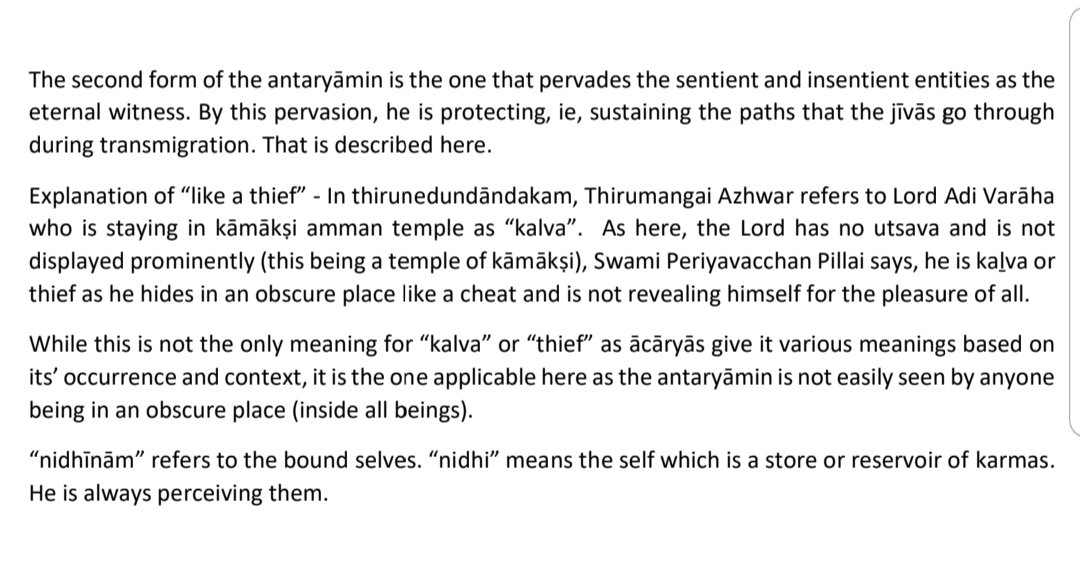
Now, from Aniruddha again, come vibhava forms which are threefold - pūrṇāvatara (Lord himself), śaktyāveśa (Lord investing powers/śaktīs in a jīva) and svarūpāveśa (Lord himself entering a jīva by svarūpa and acting through it). Next rk describes a pūrṇāvatara +
#Hinduism
#Hinduism
trīṇyeka urughāyo vi cakrame yatra devāso madanti
[One (Trivikrama) with his unlimited capacity for movement, made three steps in order that his devotees delight (gain happiness).]+
#Hinduism #Vedas #SanatanaDharma #Sanatani #SanatanDharm #RigVeda
[One (Trivikrama) with his unlimited capacity for movement, made three steps in order that his devotees delight (gain happiness).]+
#Hinduism #Vedas #SanatanaDharma #Sanatani #SanatanDharm #RigVeda
The above rk chooses Trivikrama as the best example of pūrṇāvatara. Why? How did he cause happiness for his devotees? Refer this thread where I had discussed the significance of this avatāra on the occasion of Onam:
#Hinduism #Vedas #SanatanaDharma
https://twitter.com/DefiledGod/status/1300388162619932673?s=19
#Hinduism #Vedas #SanatanaDharma
vibhirdvā carata ekayā saha pra pravāseva vasataḥ
[Two, distinct in natures, qualities, actions etc (Rāma and Lakṣmaṇa) move (in the forest) with the matchless among women, viz., Sīta (ekayā) abiding as if dwelling away from home (as ascetics).]+
This is for śaktyāveśa👇
[Two, distinct in natures, qualities, actions etc (Rāma and Lakṣmaṇa) move (in the forest) with the matchless among women, viz., Sīta (ekayā) abiding as if dwelling away from home (as ascetics).]+
This is for śaktyāveśa👇
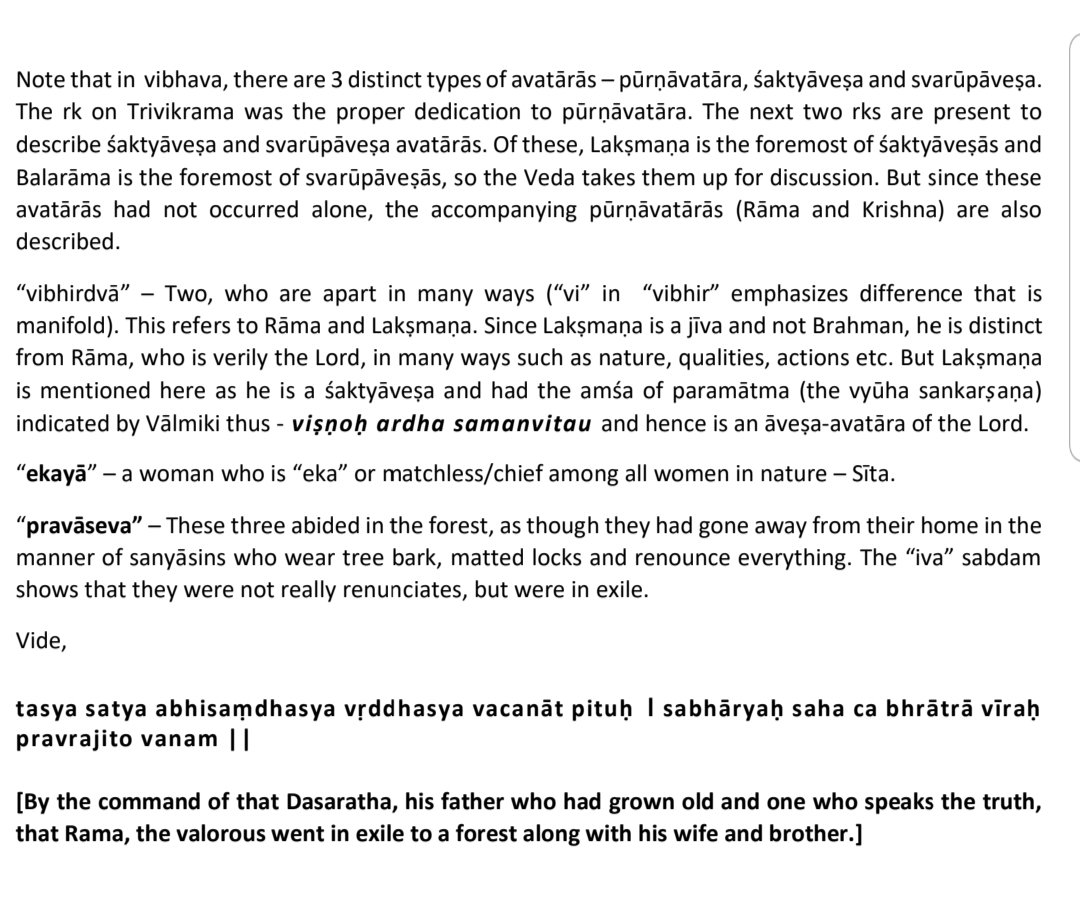
The intent of above rk is to actually include Lakṣmaṇa, a śaktyāveśa. But since he appeared along with Rāma, both have been described together with Sīta. Similarly, next rk describes a svarūpāveśa (Balarāma). But as he appeared with Krishna, both have been described as below +
sado dvā cakrāte upamā divi samrājā sarpirāsutī
[Two (Krishna and Balarāma) have made their dwelling (Dvāraka) in likeness to Svarga (divi), the two soveriegns ruling all, worshipped with or partaking of ghee (services pleasurable like ghee).]+
Explanation👇
#Hinduism
[Two (Krishna and Balarāma) have made their dwelling (Dvāraka) in likeness to Svarga (divi), the two soveriegns ruling all, worshipped with or partaking of ghee (services pleasurable like ghee).]+
Explanation👇
#Hinduism
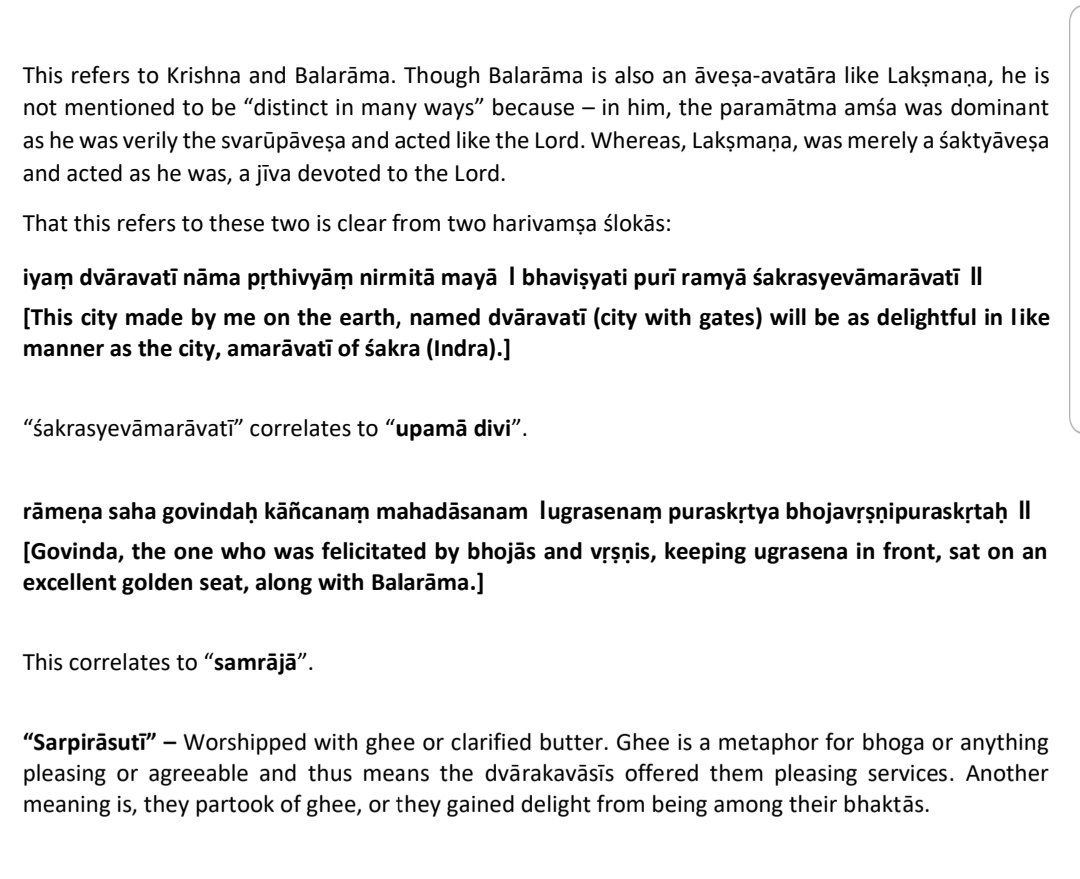
The final and greatest form of the Lord is the arca, again coming from Aniruddha. As below. Make sure to read the screenshot attached to it as the meanings are truly delightful+
#Hinduism #Vedas #SanatanaDharma #Vedic #RigVeda
#Hinduism #Vedas #SanatanaDharma #Vedic #RigVeda
arcanta eke mahi sāma manvata tena sūryamarocayan
[Shining out (making manifest) the One (form in temples), that is great due to accessibility & equal to Paravāsudeva, conceived by uninterrupted contemplation in the form of desire...+
#Hinduism #Vedas #SanatanaDharma
[Shining out (making manifest) the One (form in temples), that is great due to accessibility & equal to Paravāsudeva, conceived by uninterrupted contemplation in the form of desire...+
#Hinduism #Vedas #SanatanaDharma
...by which, the Lord who moves towards his devotees (Sūrya) is made to shine (ie, appear with same qualities & activities being thought of).]+
Screenshot below with explanation👇
#Hinduism #Vedas #SanatanaDharma #RigVeda
Screenshot below with explanation👇
#Hinduism #Vedas #SanatanaDharma #RigVeda
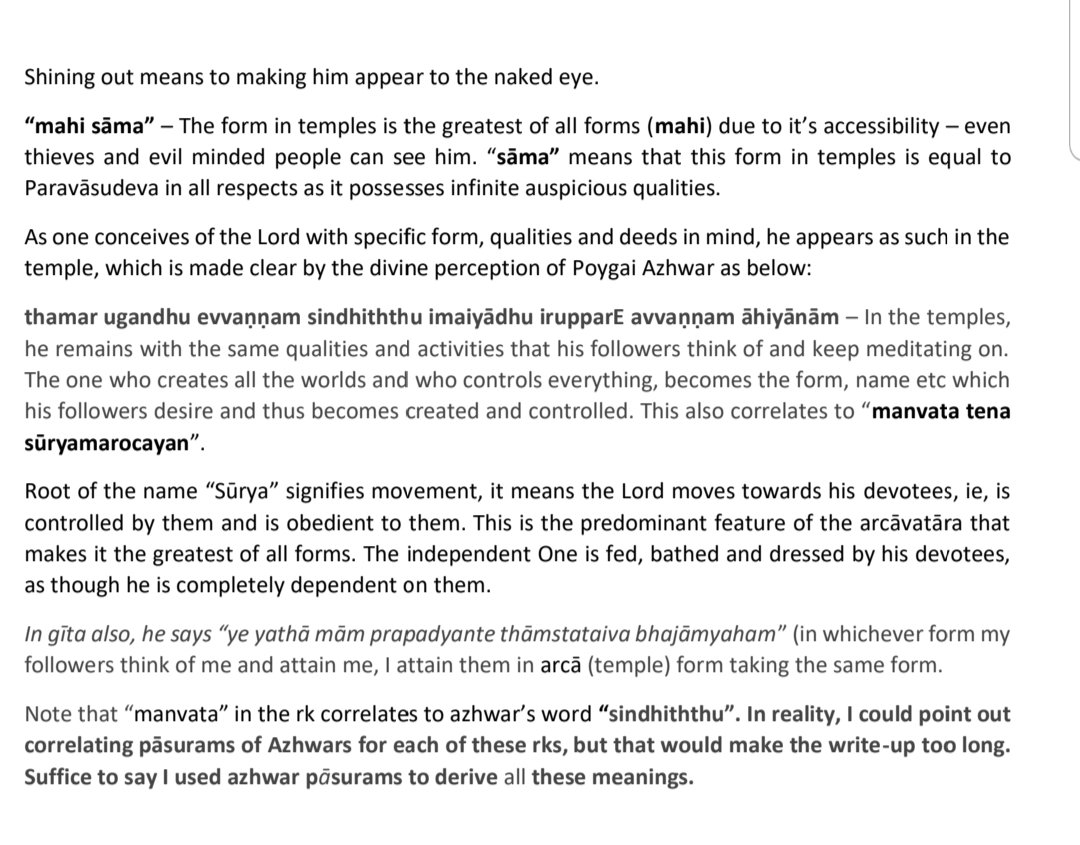
Thus, this sūkta describes the fivefold forms of the Lord, and ends with the declaration that the arca form in temples is superior to all other forms.
Hope this was insightful//
#Hinduism #Vedas #SanatanaDharma #Vedic #RigVeda
Hope this was insightful//
#Hinduism #Vedas #SanatanaDharma #Vedic #RigVeda
• • •
Missing some Tweet in this thread? You can try to
force a refresh


